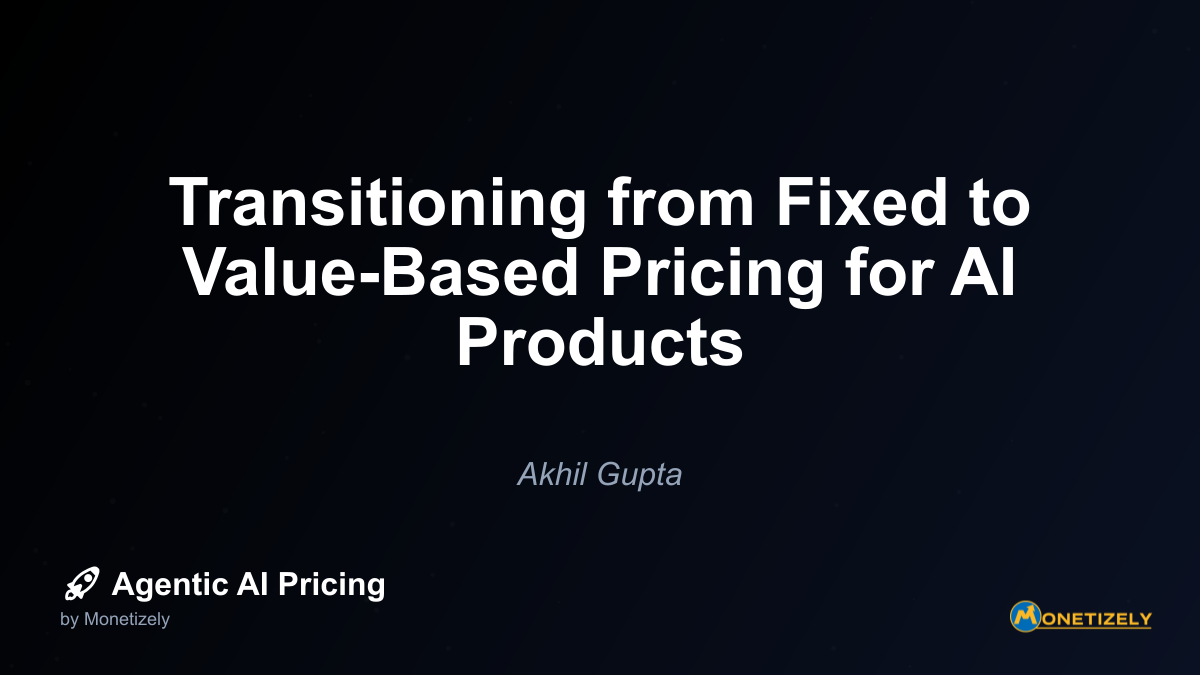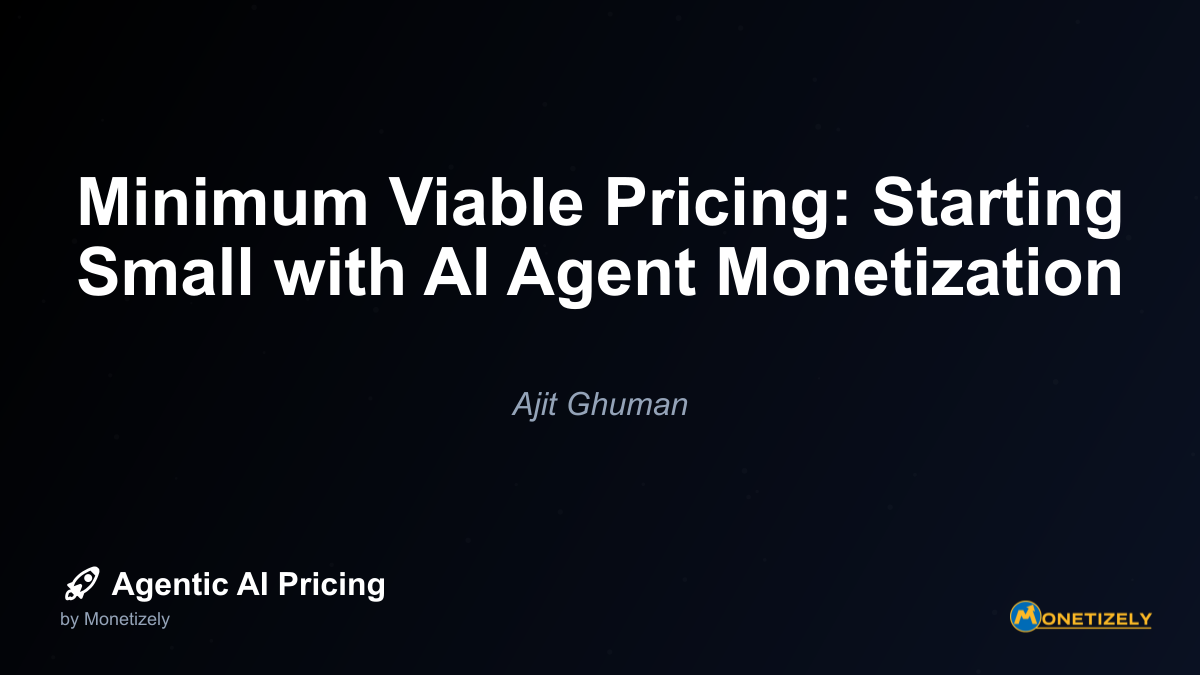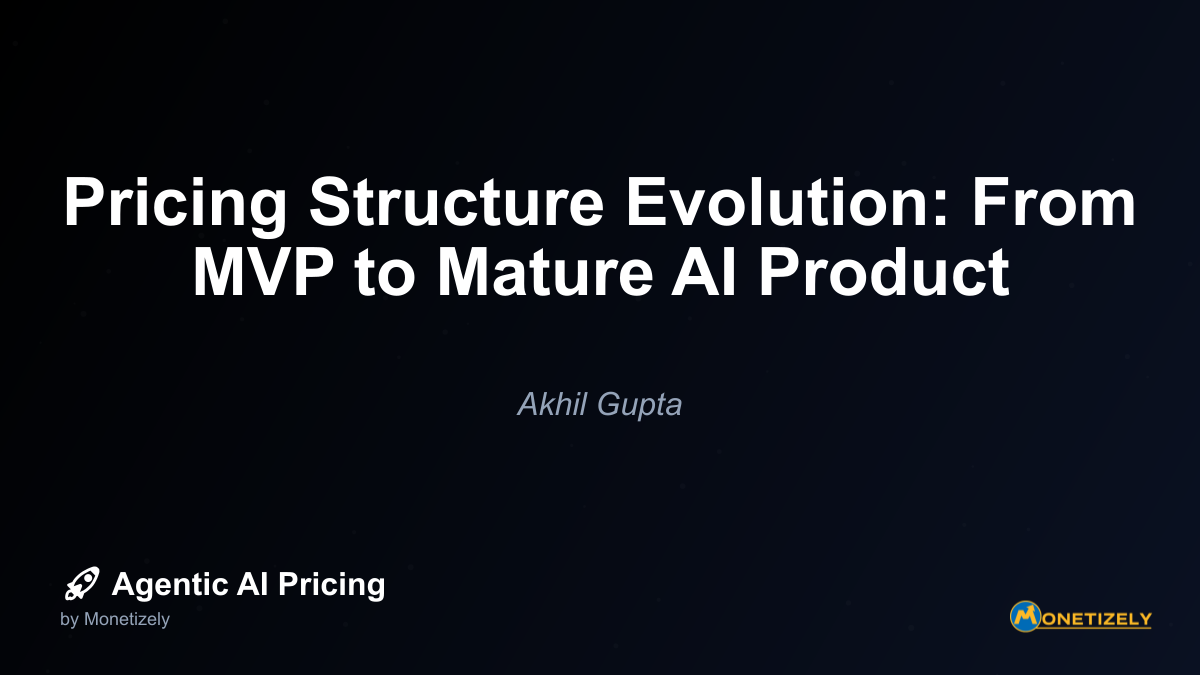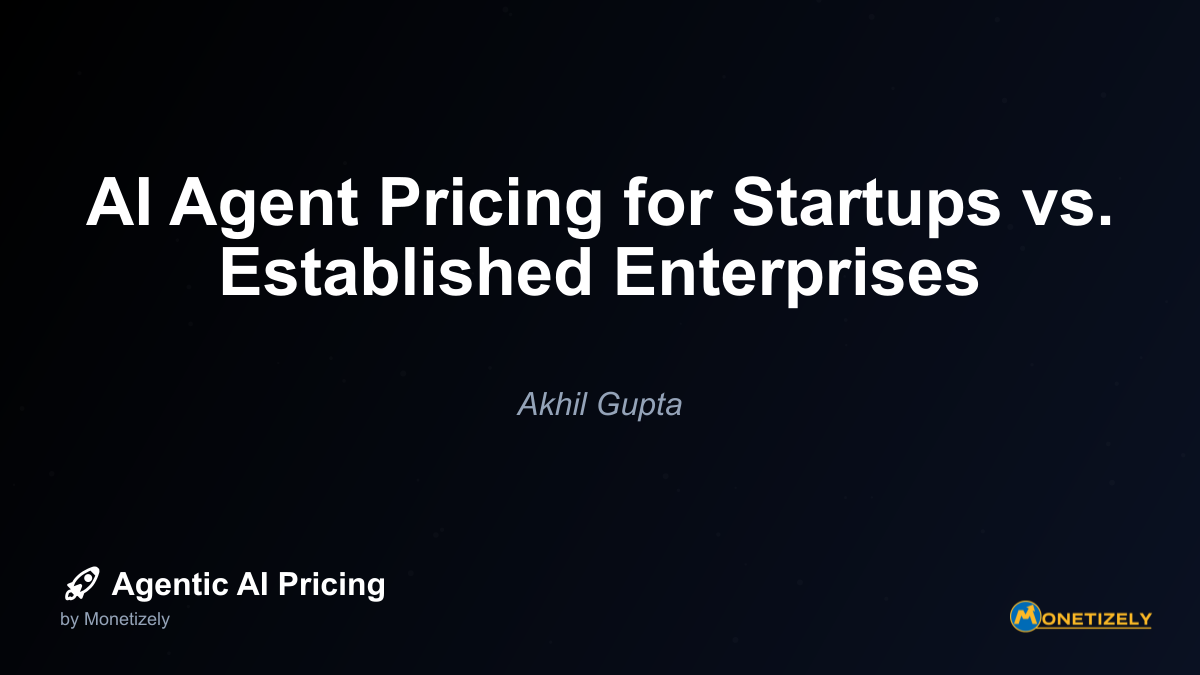· Akhil Gupta · Strategy · 13 min read
Transitioning from Fixed to Value-Based Pricing for AI Products
AI and SaaS Pricing Masterclass
Learn the art of strategic pricing directly from industry experts. Our comprehensive course provides frameworks and methodologies for optimizing your pricing strategy in the evolving AI landscape. Earn a professional certification that can be imported directly to your LinkedIn profile.

In today’s rapidly evolving AI landscape, the traditional fixed pricing models that once dominated the software industry are increasingly giving way to more sophisticated, value-aligned approaches. This shift isn’t merely a pricing strategy adjustment—it’s a fundamental rethinking of how AI products deliver and capture value in an ecosystem where outcomes matter more than inputs.
As AI capabilities advance and customer expectations evolve, organizations face the critical challenge of aligning their pricing models with the actual business value their solutions create. The journey from fixed to value-based pricing represents both an opportunity and a necessity for AI providers seeking sustainable growth and deeper customer relationships.
Understanding Traditional Fixed Pricing Models
For decades, software and technology products have relied on straightforward fixed pricing structures. These models typically fall into several categories:
Flat-fee subscriptions provide unlimited access for a set period, often with tiered feature sets that create natural upsell opportunities. This approach offers predictability for both vendor and customer but fails to account for varying usage patterns or value derived.
Per-seat licensing ties pricing to the number of users, regardless of their activity levels or the value they extract. While this model scales with customer size, it penalizes broad adoption and creates friction when organizations want to extend access.
One-time purchases with optional maintenance fees, once the standard for enterprise software, have become increasingly rare in the AI space but still exist for certain specialized applications.
The limitations of these traditional approaches become particularly acute for AI products:
Disconnect from value creation: Fixed pricing fails to account for the vastly different value outcomes that different customers achieve with the same AI solution.
Inability to capture upside: As customers derive increasing value from AI systems, fixed pricing prevents vendors from participating in that success.
Misaligned incentives: When pricing is disconnected from outcomes, vendors have less motivation to ensure customer success beyond initial adoption.
Infrastructure cost variability: AI solutions often have significant and variable computing costs that fixed pricing models struggle to accommodate.
According to recent research, companies using traditional fixed pricing for AI products experience 2.3x higher churn rates compared to those employing value-based approaches. This stark difference underscores the growing misalignment between fixed pricing and the economic realities of AI solutions.
The Case for Transitioning to Value-Based Pricing
Value-based pricing fundamentally shifts the focus from what a product costs to deliver to what it’s worth to the customer. Rather than pricing based on internal metrics like development costs or competitive benchmarks, value-based pricing anchors on the economic benefit customers receive.
For AI products specifically, value-based pricing offers compelling advantages:
Alignment with customer outcomes: By tying pricing to measurable business results, vendors create a shared success model with customers. When the AI delivers greater value, both parties benefit.
Capturing fair value across segments: Different customers derive different levels of value from the same AI capabilities. Value-based pricing allows vendors to capture appropriate returns from high-value use cases while remaining accessible to others.
Reduced adoption friction: When customers pay based on value received, the initial adoption risk decreases significantly. This can accelerate sales cycles and reduce resistance to new, unproven AI technologies.
Sustainable economics: For AI companies facing substantial and variable infrastructure costs, value-based pricing creates a more predictable relationship between costs and revenues.
The data supports this transition. According to recent research, companies adopting value-based or outcome-based pricing enjoy 40% higher gross margins and significantly lower churn compared to those sticking with seat-based pricing. About 73% of AI companies are currently experimenting with pricing models, testing an average of 3.2 models in their first 18 months of operation.
Dr. Sarah Chen from Bain highlights that cognitive AI enables multidimensional value modeling, capturing 30+ factors influencing customer value perception versus the traditional 5-7 factors. This expanded capability makes value-based pricing not just desirable but increasingly feasible for AI products.
Exploring AI Pricing Models on the Fixed-to-Value Spectrum
The transition from fixed to value-based pricing isn’t binary but exists on a spectrum with multiple viable approaches:
Usage-Based Pricing
Usage-based pricing ties costs directly to consumption metrics like API calls, processing time, or data volume. This approach aligns pricing more closely with vendor costs and customer utilization patterns.
Example: Pinecone, an AI vector database company, transitioned from fixed pricing to a serverless, pay-as-you-go structure that separates storage, reads, and writes. This aligned customer costs precisely with their individual usage and delivered up to 50x cost savings compared with prior hardware solutions.
Advantages:
- Transparent relationship between usage and cost
- Natural scaling with customer growth
- Lower barriers to initial adoption
Challenges:
- Potential for bill shock with unexpected usage spikes
- May not fully capture value variations between different use cases
- Requires robust usage monitoring infrastructure
Tiered Consumption Models
Tiered consumption models combine elements of fixed and usage-based approaches by offering predetermined usage allowances at different price points, with overage charges for exceeding limits.
Example: Cloudflare Workers adopted a pricing model based on CPU time consumption rather than duration, targeting AI developers specifically. This approach improved cost predictability and cost-effectiveness for AI workloads.
Advantages:
- Predictable costs within normal usage patterns
- Natural upsell path as customer usage grows
- Simplified billing compared to pure usage-based models
Challenges:
- Tier boundaries can create artificial usage constraints
- Less precise alignment with actual usage or value
- Potential for revenue leakage with customers at tier boundaries
Hybrid Base + Variable Models
Hybrid models combine a fixed base fee with variable components tied to usage or outcomes. This approach provides vendors with predictable baseline revenue while still capturing upside from high-value or high-usage customers.
Example: A leading AI customer service platform shifted from a fixed per-seat pricing model to a hybrid approach with a base platform fee plus variable charges based on conversation volume and resolution rates.
Advantages:
- Predictable baseline revenue
- Captures upside from high-value customers
- Reduces initial adoption risk
Challenges:
- More complex to explain and implement
- Requires balancing fixed and variable components
- May still not fully align with ultimate business outcomes
Outcome-Based Pricing
The most advanced form of value-based pricing, outcome-based models directly tie costs to measurable business results such as revenue generated, costs saved, or productivity improved.
Example: An AI-powered customer service platform charges based on the number of tickets successfully deflected from human agents, directly tying pricing to the cost savings delivered.
Advantages:
- Perfect alignment between price and customer value
- Reduced customer risk, especially for unproven solutions
- Potential for premium pricing in high-value applications
Challenges:
- Requires robust tracking of outcomes
- Attribution can be complex in multi-factor environments
- May introduce revenue timing challenges
According to recent market research, seat-based pricing among AI companies fell from 21% to 15% in just a year, while hybrid and usage/outcome-based pricing surged from 27% to 41%. This rapid shift underscores the industry’s recognition that traditional fixed models are increasingly insufficient.
Strategic Considerations Before Transitioning
Successfully transitioning from fixed to value-based pricing requires careful planning and strategic alignment. Before implementing any pricing changes, organizations should address several key considerations:
Understanding Your Cost Structure
AI solutions often have complex and variable cost profiles. Infrastructure costs may scale with usage, model complexity, or data volume. Before implementing value-based pricing, organizations must thoroughly understand:
- Fixed versus variable cost components
- Scaling economics at different usage levels
- Cost variability across customer segments
- Infrastructure optimization opportunities
This understanding forms the foundation for designing pricing models that remain profitable across the customer base.
Identifying and Measuring Value Metrics
The core of value-based pricing is identifying metrics that accurately reflect the economic benefit customers receive. These metrics should be:
- Measurable: Can be reliably tracked and quantified
- Attributable: Clearly connected to your solution’s impact
- Meaningful: Directly tied to customer business outcomes
- Actionable: Can be influenced by product improvements
For AI products, potential value metrics might include:
- Time saved on manual tasks
- Error rates reduced
- Revenue generated or influenced
- Customer satisfaction improved
- Employee productivity enhanced
According to research from Monetizely, successful AI companies typically identify 3-5 primary value metrics that drive their pricing models, with one serving as the “north star” for pricing decisions.
Assessing Customer Readiness
Not all customers will be equally prepared for or receptive to value-based pricing models. Organizations should segment their customer base according to:
- Sophistication in measuring ROI
- Budget flexibility and procurement processes
- Risk tolerance for new pricing approaches
- Current utilization and value realization patterns
This segmentation helps identify where to begin the transition and how to phase the rollout across different customer types.
Evaluating Competitive Positioning
Value-based pricing doesn’t exist in a vacuum. Organizations must consider how their new pricing approach will position them relative to competitors:
- Are competitors still using traditional fixed models?
- How will value-based pricing affect perceived price comparisons?
- Does value-based pricing create differentiation opportunities?
- How will competitors respond to pricing changes?
Preparing Internal Stakeholders
Successful pricing transitions require alignment across multiple functions:
- Sales teams need training on communicating value and negotiating based on outcomes rather than discounts
- Finance must adapt to potentially more variable revenue streams
- Product teams should prioritize features that enhance measurable value
- Customer success becomes critical for ensuring value realization
- Legal must develop new contract structures supporting value-based arrangements
According to BCG research, companies that invest in cross-functional alignment before transitioning to value-based pricing are 2.8 times more likely to achieve their revenue and margin targets.
Tactical Steps for Implementing Value-Based Pricing
Step 1: Establish Your Data Infrastructure
Value-based pricing requires robust data collection and analytics capabilities. Organizations must invest in:
Value Tracking Systems: Implement mechanisms to measure and attribute the specific outcomes your AI solution delivers. This might include:
- Integration with customer systems to capture business metrics
- Dashboards for tracking value delivery over time
- Attribution models to isolate your solution’s impact
Usage Monitoring: Deploy comprehensive tracking of how customers use your AI solution:
- Feature utilization patterns
- Processing volume and frequency
- User engagement and adoption metrics
Customer Success Metrics: Monitor indicators of successful implementation:
- Time to value realization
- Adoption breadth and depth
- Support and training utilization
This data infrastructure serves as the foundation for both pricing design and ongoing optimization.
Step 2: Design Your Value-Based Pricing Structure
With data infrastructure in place, organizations can design pricing structures that align with value delivery:
Define Your Value Units: Identify the specific metrics that will drive pricing. These should be:
- Directly connected to customer outcomes
- Easily understood by customers
- Reliably measurable by your systems
Establish Pricing Tiers: Create logical groupings based on value delivery:
- Entry-level tiers focused on core use cases
- Advanced tiers for higher-value applications
- Enterprise tiers for comprehensive deployment
Set Value-Based Rates: Determine pricing based on the economic value delivered:
- Consider the customer’s alternatives (cost of status quo)
- Analyze willingness to pay across segments
- Ensure sufficient margin across the customer base
Develop Hybrid Approaches: For many organizations, hybrid models combining fixed and value-based elements provide a smoother transition:
- Base platform fee plus outcome-based components
- Minimum commitments with upside sharing
- Feature-based tiers with usage or outcome accelerators
Step 3: Pilot with Selected Customers
Before full-scale implementation, pilot your value-based pricing with carefully selected customers:
Identify Ideal Pilot Candidates: Look for customers who:
- Have strong relationships and trust with your organization
- Demonstrate sophisticated ROI measurement capabilities
- Represent important segments for future expansion
- Are willing to partner in pricing innovation
Structure Pilot Agreements: Create special terms that encourage participation:
- Risk-sharing provisions during the pilot period
- Guaranteed pricing benefits compared to current arrangements
- Clear success criteria and evaluation timelines
Gather Comprehensive Feedback: Use the pilot to collect insights on:
- Customer perception of fairness and transparency
- Operational challenges in measuring and billing
- Sales team effectiveness in communicating value
- Financial impact on both customer and vendor
According to Monetizely’s research, organizations that conduct structured pilots with at least 5-10 customers before broader rollout are 3.2 times more likely to achieve successful pricing transitions.
Step 4: Develop Sales Enablement and Training
Equipping sales teams for value-based conversations is critical for successful implementation:
Create Value Discovery Tools: Provide sales with methods to uncover and quantify customer value:
- Value assessment calculators
- ROI modeling frameworks
- Benchmark data from similar customers
Develop New Sales Playbooks: Revise sales approaches to focus on value:
- Discovery questions focused on business outcomes
- Presentation templates highlighting value metrics
- Negotiation strategies based on value sharing
Train on Consultative Selling: Help sales teams shift from transactional to consultative approaches:
- Identifying and engaging economic buyers
- Building business cases with customers
- Managing longer, more complex sales cycles
Revise Compensation Structures: Align sales incentives with value-based pricing:
- Rewards for deals with outcome-based components
- Compensation tied to customer success metrics
- Incentives for expanding value-based relationships
Step 5: Implement Billing and Contract Systems
Value-based pricing often requires new approaches to contracting and billing:
Develop New Contract Templates: Create legal frameworks for value-based relationships:
- Clear definitions of value metrics and measurement
- Terms for data sharing and performance monitoring
- Provisions for price adjustments based on outcomes
Upgrade Billing Systems: Ensure technical capabilities for complex billing:
- Integration with value tracking systems
- Support for hybrid fixed/variable billing
- Capabilities for usage-based invoicing
Establish Governance Processes: Create oversight mechanisms for pricing execution:
- Exception handling procedures
- Approval workflows for custom arrangements
- Regular pricing committee reviews
Step 6: Communicate the Transition to Customers
Effective communication is essential when transitioning existing customers to new pricing models:
Develop Clear Messaging: Create materials explaining the transition:
- Value proposition of the new pricing approach
- Comparison with previous pricing structure
- FAQs addressing common concerns
Provide Transition Options: Offer pathways that reduce customer risk:
- Gradual migration plans with predictable costs
- Guarantees against significant price increases
- Options to remain on legacy pricing temporarily
Engage Proactively: Don’t wait for renewal to discuss changes:
- Schedule dedicated pricing discussions
- Provide personalized impact analyses
- Offer value assessment workshops
Overcoming Common Challenges in the Transition
The journey from fixed to value-based pricing inevitably encounters obstacles. Successful organizations anticipate and address these challenges proactively.
Challenge 1: Customer Resistance to Change
Customers often resist new pricing models due to budget uncertainty, procurement processes, or simple inertia.
Solutions:
- Offer transition guarantees that limit downside risk
- Provide detailed ROI analyses showing the benefits of value-based pricing
- Create budget predictability options like capped usage or outcome charges
- Implement gradual transitions with hybrid models as stepping stones
According to research, customer skepticism about value realization can be effectively addressed through proof-of-concept pilots allowing customers to validate results before full pricing commitment.
Challenge 2: Value Attribution Complexity
In complex environments, isolating the specific impact of your AI solution can be challenging.
Solutions:
- Implement controlled testing methodologies (A/B tests, phased rollouts)
- Develop multi-factor attribution models that account for various influences
- Establish clear baseline measurements before implementation
- Create mutually agreed attribution frameworks with customers
Research indicates that attribution complexity is a significant barrier, but can be reduced using controlled testing like A/B tests or phased launches.
Challenge 3: Sales Team Adoption
Sales representatives comfortable with fixed pricing may struggle with value-based conversations.
Solutions:
- Provide comprehensive training on value discovery and articulation
- Create easy-to-use tools for value quantification
- Share success stories and case studies from early adopters
- Adjust compensation to reward value-based selling behaviors
Sales teams need training to adopt consultative selling skills focused on understanding and measuring customer outcomes rather than transactional pricing.
Challenge 4: Operational Complexity
Value-based pricing often introduces new operational requirements for tracking, billing, and reporting.
Solutions:
- Invest in robust data infrastructure before full implementation
- Start with simpler value metrics that are easier to measure
- Implement clear processes for handling edge cases and disputes
- Create cross-functional teams to manage the operational transition
Challenge 5: Internal Resistance
Finance, legal, and other internal stakeholders may resist the uncertainties of value-based models.
Solutions:
- Develop comprehensive financial models showing the long-term benefits
- Create clear governance frameworks for pricing decisions
- Implement phased approaches that demonstrate success incrementally
- Engage key stakeholders early in the planning process
Real-World Examples of Successful Transitions
Case Study 1: AI-Powered Customer Service Platform
A leading AI customer service platform transitioned from a fixed per-seat pricing model to a value-based approach by linking fees to actual improvements in customer service quality and economic impact.
Approach:
- Implemented a hybrid model with base platform fee plus variable charges based on automated resolutions
- Developed a value calculator showing cost savings from reduced agent handling time
- Created performance-based agreements with clear success metrics
- Offered pilot programs to validate value before full commitment
Results:
- 42% increase in average contract value
- 28% reduction in sales cycle length
Co-Founder & COO
Akhil is an Engineering leader with over 16+ years of experience in building, managing and scaling web-scale, high throughput enterprise applications and teams. He has worked with and led technology teams at FabAlley, BuildSupply and Healthians. He is a graduate from Delhi College of Engineering and UC Berkeley certified CTO.
Pricing Strategy Audit
Let our experts analyze your current pricing strategy and identify opportunities for improvement. Our data-driven assessment will help you unlock untapped revenue potential and optimize your AI pricing approach.




